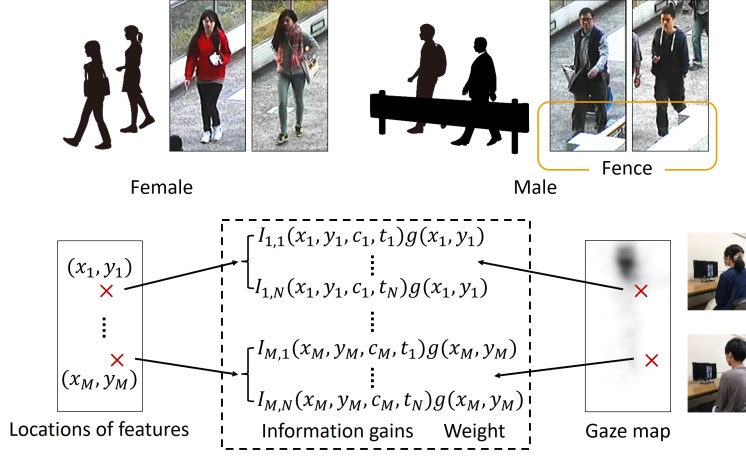
Weighted Random Forest using Gaze Distributions Measured from Observers for Gender Classification
[Abstract]
We propose a method to improve gender classification from pedestrian images using a random forest weighted by a gaze distribution. When training samples contain a bias in the background surrounding pedestrians, a random forest classifier may incorrectly include the background attributes as discriminative features, thereby degrading the performance of gender classification on test samples. To solve the problem, we use a gaze distribution map measured from observers completing a gender classification task for pedestrian images. Our method uses the gaze distribution to assign weights when generating a random forest. Each decision tree of the random forest then extracts discriminative features from the regions corresponding to the predominant gaze locations. We investigated the effectiveness of our weighted random forest using a gaze distribution by comparing the following alternatives: assigning weights for feature selection, assigning weights for feature values, and assigning weights for information gains. We compare the gender classification results of our method with those of existing random forest methods. Experimental results show our random forest using information gains weighted according to the gaze distribution significantly improved the accuracy of gender classification on a publicly available dataset.
[Publications]
- 山口 紗也加, 西山 正志, 岩井 儀雄,
視線位置分布を用いた重み付きランダムフォレストによる性別認識,
電子情報通信学会論文誌 D, Vol.J102-D, No.8, pp. 495 - 505, August 2019.- Sayaka Yamaguchi, Masashi Nishiyama, Yoshio Iwai,
Weighted Random Forest using Gaze Distributions Measured from Observers for Gender Classification,
Proceedings of 14th International Joint Conference on Computer Vision, Imaging and Computer Graphics Theory and Applications (VISIGRAPP), Vol. 5: VISAPP, pp. 273 - 280, February 2019.- 山口 紗也加, 吉村 宏紀, 西山 正志, 岩井 儀雄,
視線位置分布を用いたランダムフォレスト改良による人物性別の認識,
画像センシングシンポジウム (SSII), IS3-28, pp. 1 - 5, June 2018. [優秀学術賞]